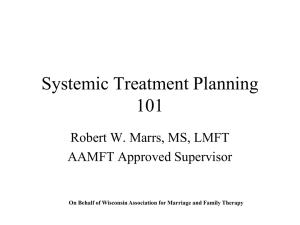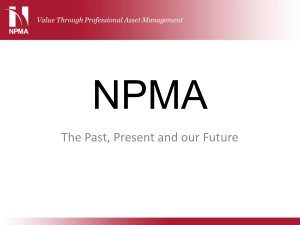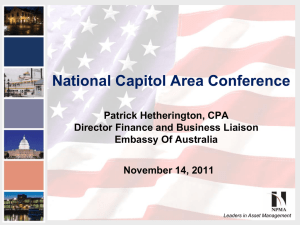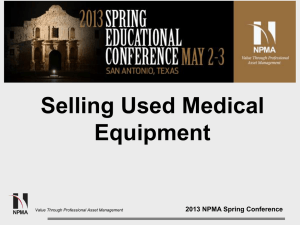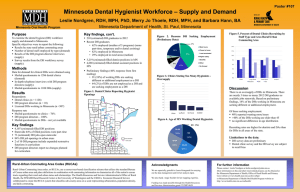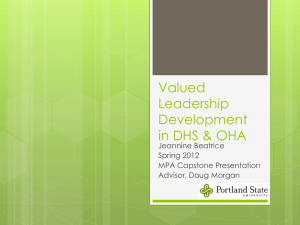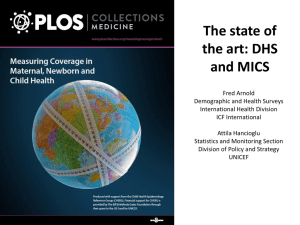Equipment Control Matrix - Federal Center
advertisement
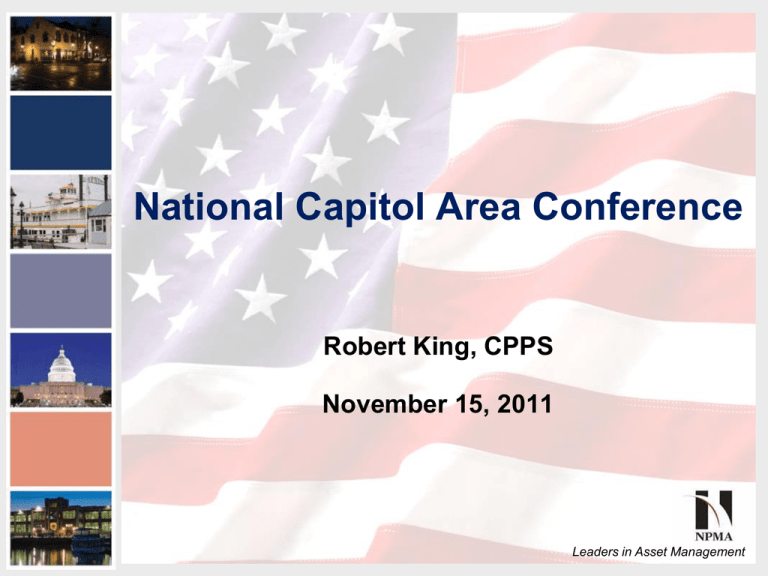
National Capitol Area Conference Robert King, CPPS November 15, 2011 2011 NPMA Conference Series III National Capital Area Conference Leaders in Asset Management Robert King E2608-08 Standard Practice for Equipment Control Matrix 2011 NPMA Conference Series III National Capital Area Conference Department of Homeland Security Policy In 2009 DHS Management adopted a 0% acceptable loss rate for Sensitive Assets • This was in direct response to audit findings • Audit recommendations were to ensure sufficient controls were instituted to: account for and control Sensitive assets throughout their life, and identify and timely report occurrences of loss, damage and destruction (LDD) 2011 NPMA Conference Series III National Capital Area Conference DHS: Sensitive Assets • Sensitive assets are defined as all assets, regardless of value, which require special control and accounting to ensure accountability and safeguarding. They include, but are not limited to: Dangerous and hazardous assets, Law Enforcement equipment, Assets authorized for storing and/or processing classified information Assets with retainable memory, Inherently portable assets and assets that can easily be converted to private use or have high potential for theft 2011 NPMA Conference Series III National Capital Area Conference DHS: Sensitive Assets • 0% acceptable loss rate was a point of contention between Management and DHS Components • Needed approach for balancing both Management’s objectives and Component’s Concerns • Other audit findings that needed to be addressed included DHS Management providing: • Standard classification and identification of assets • Consistent, compressive direction on appropriate 2011 NPMA Conference Series III accountability controls National Capital Area Conference E2608-08 Standard Practice for Equipment Control Matrix • This practice describes equipment control classes (ECCs), equipment control levels (ECLs), and their relationships. • The ECCs provide standard classes for equipment based on control and tracking requirements for the equipment. • Establishes a standard equipment control methodology to aid in requirements determination and communication with the end goal of the promulgation of safe, secure, cost effective, and risk appropriate control and tracking methodologies. 2011 NPMA Conference Series III National Capital Area Conference E2608-08 Equipment Control Matrix Equipment Control Matrix Equipment Control Levels B. C. D. Equipment Control Classes (ECCs) A. Consequence of Loss of Control Continuous Continuous While Mobile Event Tracking Containment No Tracking 1. Societal Safety/Security Impact S I I I I D S I I I D D S I I D D D S I NR NR NR D S 2. Personal Safety/Security Impact 3. Operational Impact 4. Compliance Impact 5. No Discernable Impact S = Standard Control & Tracking I = Increased Control and Tracking D = Decreased Control and Tracking E. NR = Not Recommended 2011 NPMA Conference Series III National Capital Area Conference DHS: Equipment Control Matrix for Sensitive & Accountable Assets 2011 NPMA Conference Series III National Capital Area Conference DHS: Equipment Control Matrix Sensitive Assets 2011 NPMA Conference Series III National Capital Area Conference DHS: Equipment Control Matrix Sensitive Assets 2011 NPMA Conference Series III National Capital Area Conference DHS: Equipment Control Matrix Sensitive Assets 2011 NPMA Conference Series III National Capital Area Conference DHS: Equipment Control Matrix Accountable Assets 2011 NPMA Conference Series III National Capital Area Conference Value of Equipment Control Matrix • DHS Management has approved industry recognized acceptable loss rates for ECCs 2, 3 and 4, but has maintained a 0% acceptable loss rate for ECC 1 • Additional controls tailored and applied to the vulnerabilities associated with classes of assets • Providing departmental guidance around standard classifications and controls for asset types 2011 NPMA Conference Series III National Capital Area Conference Next Steps with Instituting Equipment Control Matrix • Instituting within each DHS Component to adopt their classification system to the ECCs and incorporate into monthly LDD reporting • Adopting within policy and instruction • Providing a platform for demonstrating sufficient DHS guidance and controls to close outstanding audits 2011 NPMA Conference Series III National Capital Area Conference
